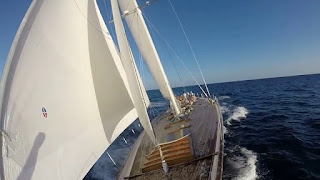
The Pyramid of Sailing
Improving our sailing is what it’s all about. The reason we head out each week to the race course is to sail as well as we can, as yachtsmen and women we thrive on the competition and whilst nearly always glad to be just out on the water. The fact remains we all have a much bigger smile on our face when we have won.
Sailing is a very complicated sport, in order to do well we require a huge knowledge base. In fact we never stop learning. On a typical day on the water so many variables can be encountered which can lead to so many possible scenarios, how we deal with them determines success or failure.
I am often bemused by fellow yachtsmen who spend a great deal of time on the more advanced racing tactics and subtleties of sailing when on the water I see them struggle to master even the fundamentals. Before we can really develop as sailors we need to prioritise our goals. We need to go back to the basics and learn how to handle our vessels before anything else comes into play.
The often referred “Pyramid of Sailing” should be the structure of all our development, it consists of three levels. On the first level we have boat handling, this is a mandatory requirement of sailing, and we need to know how our boat will behave in most conditions. Failure to do so is not only foolhardy but dangerous, not only to ourselves but to our crew and even the crews of other vessels. The second level which naturally leads on is boat speed; obviously our awareness of the nuances of boat handling will make boat speed a lot easier to develop. On the top level is tactics, proactive tactical manoeuvres are virtually impossible without good boat handling and speed. So in order to develop we must work our way up through the three levels.
Boat handling- as befits the base of our pyramid, boat handling encompasses a wide and broad platform. It involves everything from being able to get our boat out of its pen to mastering a snappy lee bow at the top mark without infringing. The best way to learn how our boat responds is to simply go sailing, find out how it responds in various manoeuvres and conditions; this will make it a lot easier to judge what you can and can’t do. We need to be able to operate our boat in tight situations at starts and mark rounding’s, we need to know our limitations and work on broadening them as we develop our expertise. A piece of advice that has always stuck with me was an ex Olympian who spends some time helping out as a tactician on various boats, he said “the first thing to ascertain as a tactician on a new boat is how many arrows you should leave in you quiver”. The ability to handle your boat competently will broaden your sailing options significantly. This will enable you to use more of those arrows where appropriate.
Obviously as a crew you need to practise all the drills- tacking, gybing, drops, peels and sail changes as much as you can, as part of this practise you should also develop and improve on why and how you do things.
As part of our boat handling education it is imperative to know the sailing rules we race under. I am amazed at the lack of even the broadest understanding of the rules on some boats. I encourage everyone to get a rule book and study it; some have appendices which give excellent tutorials. With your crew learn a rule a week.
To sum up good boat handling we simply need to be capable of putting the boat where we want it to be with confidence.
Boat Speed- The ability to handle our boat well will make our quest for competitive boat speed much easier, the quest for speed is subtle and requires a lot of finesse. We can use our competence to improve our speed round the track through better tacking, gybing, sail setting and dousing. Our improved knowledge of our yachts behaviour will help our starts with the ability to accelerate or slow down as a unit. We will be able to work on sail and rig trim, better steering techniques and positioning our boat better. Better-quality boat handling will always result in superior speed.
Tactics- “Boat speed makes you a tactical genius”. An old adage which rings very true. Ask any tactician and he / she will agree. There is nothing worse than doing tactics on a boat lacking speed. It is virtually impossible to find a passing lane when your competition is sailing away from you. The art of tactics has a quite a different aspect from boat handling and speed in that it revolves around how we react to circumstances like wind variations, tidal currents and other boats as they change. The ability to do a close slam dunk or a quick gybe will enhance our tactical options dramatically. If the tactician has confidence in the boatspeed and the crew work then their job suddenly becomes a whole lot easier.
So to improve your performances on the water, remember the pyramid of sailing. Start off with developing your boat handling and the rest will flow on from there. There are no shortcuts; the only way to climb a pyramid is from the base up.



Comments
Post a Comment